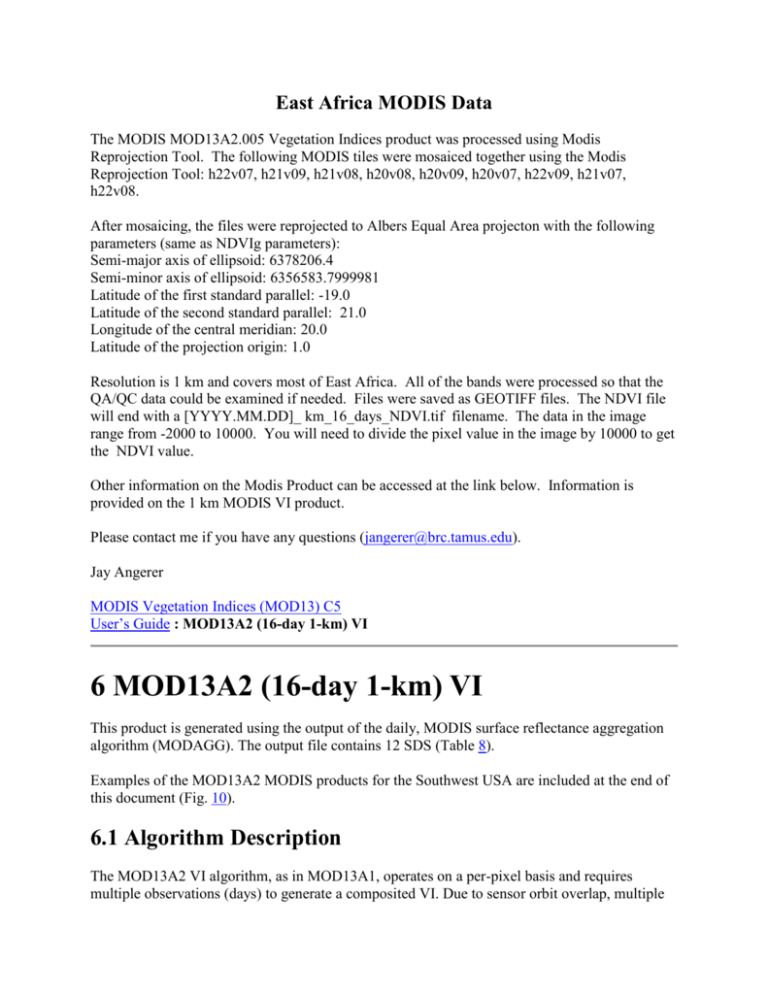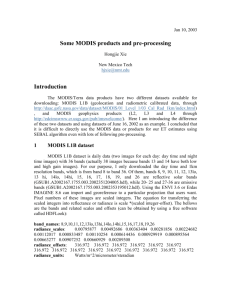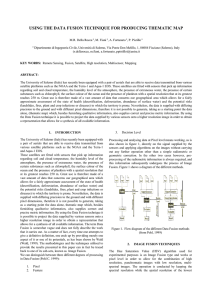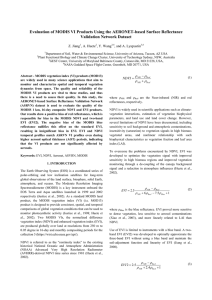6 MOD13A2 (16-day 1
advertisement

East Africa MODIS Data The MODIS MOD13A2.005 Vegetation Indices product was processed using Modis Reprojection Tool. The following MODIS tiles were mosaiced together using the Modis Reprojection Tool: h22v07, h21v09, h21v08, h20v08, h20v09, h20v07, h22v09, h21v07, h22v08. After mosaicing, the files were reprojected to Albers Equal Area projecton with the following parameters (same as NDVIg parameters): Semi-major axis of ellipsoid: 6378206.4 Semi-minor axis of ellipsoid: 6356583.7999981 Latitude of the first standard parallel: -19.0 Latitude of the second standard parallel: 21.0 Longitude of the central meridian: 20.0 Latitude of the projection origin: 1.0 Resolution is 1 km and covers most of East Africa. All of the bands were processed so that the QA/QC data could be examined if needed. Files were saved as GEOTIFF files. The NDVI file will end with a [YYYY.MM.DD]_ km_16_days_NDVI.tif filename. The data in the image range from -2000 to 10000. You will need to divide the pixel value in the image by 10000 to get the NDVI value. Other information on the Modis Product can be accessed at the link below. Information is provided on the 1 km MODIS VI product. Please contact me if you have any questions (jangerer@brc.tamus.edu). Jay Angerer MODIS Vegetation Indices (MOD13) C5 User’s Guide : MOD13A2 (16-day 1-km) VI 6 MOD13A2 (16-day 1-km) VI This product is generated using the output of the daily, MODIS surface reflectance aggregation algorithm (MODAGG). The output file contains 12 SDS (Table 8). Examples of the MOD13A2 MODIS products for the Southwest USA are included at the end of this document (Fig. 10). 6.1 Algorithm Description The MOD13A2 VI algorithm, as in MOD13A1, operates on a per-pixel basis and requires multiple observations (days) to generate a composited VI. Due to sensor orbit overlap, multiple observations may exist for one day, hence the aggregation algorithm (MODAGG) precedes the VI algorithm. MODAGG will ingest all the daily projected (tile) surface reflectance data and generate a maximum of four observations based on quality, cloud cover, and viewing geometry. In theory, this can result in a maximum of 64 observations over a 16-day cycle, however, due to the presence of clouds and the actual sensor spatial coverage, this number will range between 64 and 0 with decreasing observations from higher to equatorial latitudes. Please see Subsection 5.1 “MOD13Q1/A1 Algorithm Description” for full details of the MODIS VI compositing method followed also for the MOD13A2 product. 6.2 Scientific Data Sets The 1-km VI product has the following 12 Science Data Sets (Table 8): Table 8: Product MOD13A2: 16-day 1-km VI. Science Data Set Units Data type Valid Range Scale factor 1km 16 days NDVI NDVI int16 -2000, 10000 0.0001 1km 16 days EVI EVI int16 -2000, 10000 0.0001 1km 16 days VI Quality detailed QA Bits uint16 0, 65534 NA 1km 16 days red reflectance (Band 1) Reflectance int16 0, 10000 0.0001 1km 16 days NIR reflectance (Band 2) Reflectance int16 0, 10000 0.0001 1km 16 days blue reflectance (Band 3) Reflectance int16 0, 10000 0.0001 1km 16 days MIR reflectance (Band 7) Reflectance int16 0, 10000 0.0001 1km 16 days view zenith angle Degree int16 -9000, 9000 0.01 1km 16 days sun zenith angle Degree int16 -9000, 9000 0.01 1km 16 days relative azimuth angle Degree int16 -3600, 3600 0.1 1km 16 days composite day of the year Day of year int16 1, 366 NA 1km 16 days pixel reliability Rank int8 0, 4 NA 6.3 Product Specific Metadata A listing of the metadata fields used for QA evaluations of the MOD13A2 VI product is included in Table 9. Table 9: Metadata fields for QA evaluation of MOD13A2. I. Inventory Metadata fields for all VI products (searchable) QAPERCENTINTERPOLATEDDATA QAPERCENTMISSINGDATA QAPERCENTOUTOFBOUNDSDATA QAPERCENTCLOUDCOVER QAPERCENTGOODQUALITY QAPERCENTOTHERQUALITY QAPERCENTNOTPRODUCEDCLOUD QAPERCENTNOTPRODUCEDOTHER II. Product specific metadata (searchable) Product Specific Metadata variable name (Best Quality) MOD13A2 NDVI1KM16DAYQCLASSPERCENTAGE MOD13A2 EVI1KM16DAYQCLASSPERCENTAGE III. Archived Metadata (not searchable) Product Metadata variable name (Array of QA usefulness histogram) MOD13A2 QAPERCENTPOORQ1KM16DAYNDVI MOD13A2 QAPERCENTPOORQ1KM16DAYEVI 6.4 Global and Local Metadata Attributes As in all MODIS products, the global metadata is written to the ouput file during the generation process and could be used for searching the archive about the product. A listing of relevant metadata is provided. 6.5 Quality Assurance In principal, the QA metadata objects and QA SDS’s of the MOD13A2 product are the same as those of the MOD13A1 product. In this section, we only describe the differences of the MOD13A2 product QA from the MOD13A1 product QA. QA Metadata As the spatial resolution of the MOD13A2 product differs from that of the MOD13A1 product, the 4 VI PSA object names differ correspondingly. Table 10 lists the correspondences between these object names. Table 10: Correspondence of the VI PSA QA Metadata Object Names between MOD13A2 and MOD13A1 products. Object Name in the MOD13A2 Object Name in the MOD13A1 NDVI1KM16DAYQCLASSPERCENTAGE NDVI500M16DAYQCLASSPERCENTAGE EVI1KM16DAYQCLASSPERCENTAGE EVI500M16DAYQCLASSPERCENTAGE QAPERCENTPOORQ1KM16DAYNDVI QAPERCENTPOORQ500M16DAYNDVI QAPERCENTPOORQ1KM16DAYEVI QAPERCENTPOORQ500M16DAYEVI QA Science Data Sets VI usefulness index computation is performed according the criteria showed in Table 11. VI Pixel reliability is described in ’Pixel reliability summary QA’ SDS (Table 4), and detailed QA bit fields are described in ’VI Quality detailed QA’ SDS (Table 5). Table 11: VI Usefulness Index Scaling Method for the MOD13A2 Product. Parameter Name Condition Score Aerosol Quantity (bits 6-7) Low or average aerosols 0 Climatology aerosols 2 High aerosols 3 Atmosphere BRDF Correction Performed 0 (bit 9) Not performed 2 Mixed Clouds (bit 10) No mixed clouds 0 Possible mixed clouds 3 Shadows (bit 15) No shadows 0 Possible shadows 2 View zenith angle ( ) 1 If 40 Sun zenith angle ( ) 1 If 60









